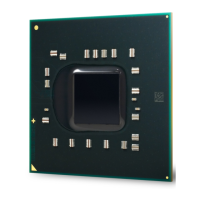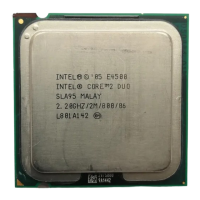Datasheet
19
Low Power Features
2.2 Enhanced Intel SpeedStep® Technology
The processor features Enhanced Intel SpeedStep Technology. Following are the key
features of Enhanced Intel SpeedStep Technology:
• Multiple voltage and frequency operating points provide optimal performance at the
lowest power.
• Voltage and frequency selection is software-controlled by writing to processor
MSRs:
— If the target frequency is higher than the current frequency, V
CC
is ramped up
in steps by placing new values on the VID pins, and the PLL then locks to the
new frequency.
— If the target frequency is lower than the current frequency, the PLL locks to the
new frequency and the V
CC
is changed through the VID pin mechanism.
— Software transitions are accepted at any time. If a previous transition is in
progress, the new transition is deferred until the previous transition completes.
• The processor controls voltage ramp rates internally to ensure glitch-free
transitions.
• Low transition latency and large number of transitions possible per second:
— Processor core (including L2 cache) is unavailable for up to 10 μs during the
frequency transition.
— The bus protocol (BNR# mechanism) is used to block snooping.
• Improved Intel® Thermal Monitor mode:
— When the on-die thermal sensor indicates that the die temperature is too high
the processor can automatically perform a transition to a lower frequency and
voltage specified in a software-programmable MSR.
— The processor waits for a fixed time period. If the die temperature is down to
acceptable levels, an up-transition to the previous frequency and voltage point
occurs.
— An interrupt is generated for the up and down Intel Thermal Monitor transitions
enabling better system-level thermal management.
• Enhanced thermal management features:
— Digital Thermal Sensor and Out of Specification detection.
— Intel Thermal Monitor 1 (TM1) in addition to Intel Thermal Monitor 2 (TM2) in
case of unsuccessful TM2 transition.
— Dual-core thermal management synchronization.
Each core in the dual-core processor implements an independent MSR for controlling
Enhanced Intel SpeedStep Technology, but both cores must operate at the same
frequency and voltage. The processor has performance state coordination logic to
resolve frequency and voltage requests from the two cores into a single frequency and
voltage request for the package as a whole. If both cores request the same frequency
and voltage, then the processor will transition to the requested common frequency and
voltage. If the two cores have different frequency and voltage requests, then the
processor will take the highest of the two frequencies and voltages as the resolved
request and transition to that frequency and voltage.
The processor also supports Dynamic FSB Frequency Switching and Intel Dynamic
Acceleration Technology mode on select SKUs. The operating system can take
advantage of these features and request a lower operating point called SuperLFM (due
to Dynamic FSB Frequency Switching) and a higher operating point Intel Dynamic
Acceleration Technology mode.
